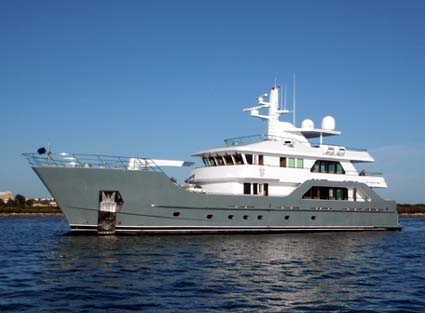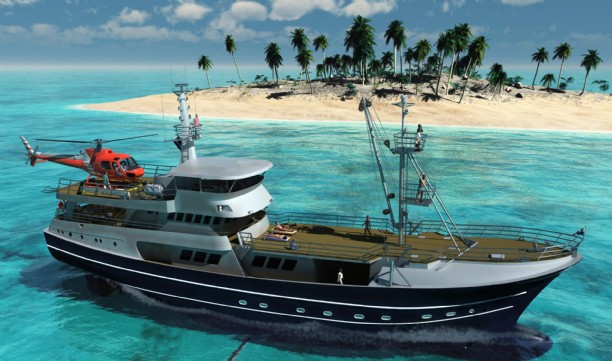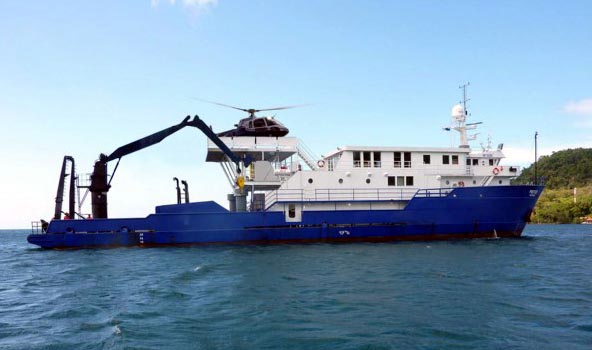The Pros and Cons of Conversion Vs. New Build for Explorer Yachts
Please see the article below by John DeCaro, president of All Ocean Yachts.
O: 954-671-0107C: 954-646-1411
JohnD@alloceanyachts.com
Conversion Expedition Yacht


New Construction Expedition Yacht


I have had a number of clients who have inquired about converting commercial or military vessels to Explorer Yachts versus starting from a clean sheet of paper and building a purpose-built Expedition yacht to meet their mission profile. I have spoken at length with them regarding this and done quite a bit of research. A number of people have asked me to put my thoughts down in writing so here it is. Please keep in mind that this is a short answer to a complex question.
The first question I receive is "Which is better, a new build or conversion expedition yacht?". Right off the bat, I have to say that there is no clear cut answer to this. It all goes to the mission profile of the vessel, how you will use it, what you expect from it, what level of finish you need, how it will be operated, what the layout requirements are, what special features are needed to meet the intended use, size, draft, speed requirements, budget and a host of other items.
Examples, but by no means a full list of these are as follows:
|
|

New Expedition Yacht Coming Out of the Shed
There are a set of criteria that fit very well if you want to do a conversion and a set that do not fit well at all and of course a point where they blend together. You may want to look at it as a sliding scale, 1 being a conversion is great, 100 being a very bad idea, build or buy.
Often times the next question is "Which is the better value or investment?".
It is my experience that most conversions lose money when they are sold and cost much more than originally estimated to complete. I would say that if you use percentages, the losses are much higher than with custom Explorer yachts. Some conversions do sell for more then what they cost to acquire and to convert the vessel. Some custom Explorer yachts sell for more than their cost to build even several years later.
However percentages can be deceiving. A loss of 20% on a total conversion cost of $4,000,000 is the same as the loss of 10% on an $8,000,000 new construction. A profit of 10% on an $8,000,000 vessel is a lot more the 10% on a $4,000,000. The issue here is that the loss on a conversion is more in the 50% to 70% and the chances of breaking even or making a profit on a new build custom project are much higher. So if you are playing the odds, your investment in a new build Explorer is safer overall than a conversion.
I will often hear the client say "I do not care about the resale value." This statement holds true right up to the moment they need to sell the vessel, then it is a very big issue.
In historic terms new builds have been a much better investment over time than conversions.
ALWAYS TAKE CARE FOR THE INTRINSIC VALUE OF THE VESSEL YOU ARE BUILDING OR CONVERTING!
The third question is which is the better sea boat or the safest vessel for cruising the world. This really should be the 2nd or even the 1st question! After all who cares about resale value or a whole list of requirements if the boat is not safe to accomplish its mission profile?The good news is the answer to this is very simple and unambiguous, they are both equally safe if designed and/or converted properly.
Another question that often gets asked is, "How do I make sure that I am going to get what I was expecting and control costs in a conversion or of a new build Explorer or Expedition vessel?"
This is again a complex question which starts with looking at all of the criteria needed to meet your goals and putting in place the right team to make sure you can reach them with in the parameters you have created.

New Expedition Yacht
Here is where I have to give myself and All Ocean Yachts a bit of a plug. The first thing you need to do is make sure you are working with a group that has a solid background in Expedition yachts. EXPLORER YACHTS ARE VERY DIFFERENT FROM A NORMAL BIG WHITE YACHT! So find yourself a group that has extensive background in this field. The person you are working with needs to understand and know the market to help sort out which is the best place to start, a conversion from scratch, an all ready converted vessel, an existing Explorer or Expedition vessel or new construction of an Explorer / Expedition / Adventure yacht.
This should always start with the first question above and the list of criteria and mission profile.

An Example of a well done General Arrangement for an Explorer Yacht
The big question is, "What are the criteria that fits well with doing a conversion?"
As mentioned above, the owner needs to have a good background in yachting and understand the build process. A conversion is always going to bring you more problems and issues to sort through than starting with a clean sheet of paper. The further the vessel is from ideal the more things that will come up. The owner and project team need to be flexible and creative to keep moving the project forward on time and on budget. There are some specific programs and checks and balances that can be put into place to track costs and progress now that were not available even a few years ago.
The existing vessel's structure should be as close to its converted form as possible and lend itself to easy modification. Basic steel and aluminum work is really very easy and cost effective to do. Changing the shape of the bow, adding some length to the stern, extending a house, adding a flybridge, extending over hangs are not a big issue. Wiping the whole superstructure off and just keeping the hull would, but you are closer to the middle on a sliding scale that may or may not take you over the edge.

Explorer Yacht Conversion Rendering for BALBOA
The internal structure and how the water tight compartments are arranged in the hull is a key item. When you have to start changing bulkheads this slides the needle way over.
The more refined you want the exterior and interior to be will move the needle very quickly to the 100 side of things. Do not try to take a pig's ear and make it into a silk purse. If you want a vessel that looks like a white yacht inside and out you should build a new boat because a large amount of the cost is in those finishing items and you are much better off putting that money into a new platform rather then ending up with a new exterior and interior on a 20 year old boat.
Please keep in mind, no matter what you spend the vessel when finished will be a conversion of an old commercial vessel!
A key item to keep in mind is on a new build the cost of the hull and superstructure is between 15 to 20% of the cost of the project. Engines, drive trains, generators and electrical panels are a small amount overall. The more of this you have to remove and replace or upgrade the more you're heading to the 100 side of the scale.
There are a lot of other items that can move the scale higher.
The zero side of the scale:
Now let's talk on the positive side of things. When does the conversion work? First the boat in general, if your requirements match a broad set of features of a commercial vessel or if you have very specific features like fully certified helicopter pads, you are planning on operating in WINTER ice in the Artic sea or Antarctic, will operate the vessel a good deal of time in waters with a good deal of exposure to piracy or other external dangers, if there are commercial or military vessels whose hull compartments and superstructure match very close to your requirements, you are happy with an exterior and interior level of finish that is simple and easy to retro fit into the vessel and is not a large proportion of the over all budget. Then you are going to be very close to the zero side.
Before Conversion PROTEUS

After Conversion PROTEUS

I am going to end this on a few generalities of the intended vessel and a final statement. First buy as new a vessel to convert as possible, the vessel should have been built to class and even better still be in class and in operation. The major equipment in the vessel should have a high level of serviceability and be well known and highly respected. Up dating engines and generators is ok, as long as it is a simple switch out. A vessel built by a well known yard or military is much better then one built by a no name builder. Do not get hung up on things like ice class or ice breaker unless you plan on winter polar use. Maintaining the vessel to these classes is very expensive and a well built commercial hull can operate in most conditions of summer or light ice.
If the needle is near the zero line and it looks good to do the conversion, STOP, FIRST GO LOOK FOR A BOAT SOMEONE ELSE HAS CONVERTED AND SEE IF YOU CAN TWEAK IT TO YOUR NEEDS. Fortunately or unfortunately depending on your point of view there are a good number of projects that were started and left unfinished or finished and being sold because they did not do a careful study. There are also some that were done right and have served their owners well and they are now ready to move to other adventures.
Take advantage of the other person's experiences, investments in time and money converting the vessel to an Explorer yacht if at all possible.
If the only answer is to do a conversion to a Explorer Yacht / Expedition Yacht / Adventure Yacht from scratch, work with someone who knows about them, who can help you put a team together, can work through all the issues with you and be ready for the adventure to begin with the start of the conversion and end with a great deal of joy from cruising the world and seeing remote and not often visited areas with your family and friends!
I am happy to answer any questions, please contact me at:
John DeCaro
President
All Ocean Yachts
O: 954-671-0107
C: 954-646-1411
JohnD@alloceanyachts.com
Links on this site:
All Ocean Yachts Design Page
All Ocean Yachts Brokerage Page